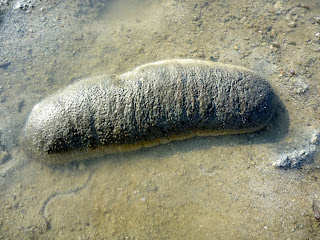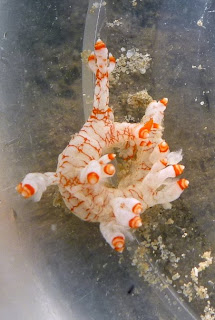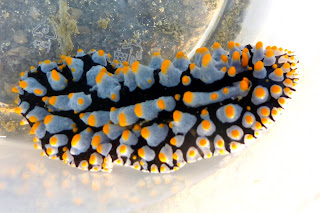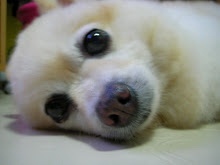The inspiration of Spongebob Square Pants (or so I say), the Sea Sponge is often thought to be a plant. Not surprising because this animal looks very much like one, without the typical facial features and movement. Comprising of very few cells, this animal (is an animal because) feeds by pumping water in and out of itself, picking up detritus in the process. Interestingly, dried sea sponges are used at home by people in the past. Thankfully, the ones we use now are synthetic sponges, else we end up overcollecting again.
The Hairy Crab (Pilumnus vespertilio) played dead in our path. Strangely, this cute teddy was not camouflaging itself against a sponge or a rock per usual. The long hairs on its body and limbs trap sediments to help it blend into the surroundings. In water, it fluffs up which breaks its body outline, making it difficult for predators to spot its presence. Not the 大闸蟹 that participants are more familiar with, this hairy crab is in fact mildly poisonous due to its diet.
The shore was like a mini childcare centre with the hunter seekers' excellent finds of 3 juvenile Cushion Star (Culcita novaeguineae)! I have seen #3 on past trips (and it certainly has grown!), but not #1 and #2! Great news that our shores are alive and growing!
Junior #1
Junior #2
Junior #3
Grandparent Cushion Star was also sighted! This star certainly left all of us in awe with its sheer size. Participants were surprised that the Cushion Star can grow to such size (almost >20cm wide)! With thick calcified walls and a rounded shape, the Cushion Star is a tough nut for predators to bite on.
With Valentines' day just passing us by, the courtship celebration certainly has not ended for the Sandsifting Seastars (Archaster typicus). Many pairs were seen in their psuedo-copulation position, getting ready to release the sperms and eggs (without any contact of their reproductive organs) when the tide comes in.
Of course, how can we miss the iconic Knobbly Sea Star (Protoreaster nodosus)? The participants were thrilled to see the real thing after much anticipation from spotting a picture of it at the visitor centre. Named after the knobs on its body, this Sea Star also also has a calcified thick body that makes life more difficult for predators. Even with this natural art of defence, the Knobbly is still endangered due to the aquaruim trade and loss of habitat.
My fellow guide explained the over-collection of the Sandfish Sea Cucumber (Holothuria scabra) due to its popularity as a dish on our tables. Belonging to the same family as Sea Stars, these Sea Cucumbers circulates water through its body (vis-a-vis us our blood circulatory system) and thus we shouldnt remove them out of water unneccessarily to prevent stressing them out. While edible, they must be processed first as they are mildly poisonous.
Our second Sea Cucmber of the day was the Synaptid Sea Cucumber (Family Synaptidae). The longest species that can grow up to 3m long, this individual was gingerly lashing its feathery tentacles in the water to pick up detritus. Without tube feet, they hold on to the substrate with hooked spicules instead, similar to how velcro works. Its thin dedicate wall is certainly one good reason why we shouldnt handle them.
Smooth to the touch and looking just like a polished stone, the Stonefish Sea Cucumber (Actinopyga lecanora) is a better player at beauty care, a stark contrast to the Sandfish Sea Cucumber's rough skin that we encountered earlier in the walk.
Another beauty was the Moon Snail (Polinices sp.), looking ever pearly and white like the full moon. This fellow stealthily burrowed into the sand while we were introducing the Sandfish Sea Cucumber by its side. A fierce predator of other clams and snails, the Moon Snail uses its huge body to suffocate its prey. Failing which, it secretes an acid to create a hole in the prey's shell before inserting its radula to enjoy a hearty meal.
I can never get enough of this shore, because there is never an end to the animals to see (especially when my first sightings) ! My first encounter with the Bornella stellifer Nudibranch. A sea slug, Nudibranches are born with shells but sheds them as they grow older. For protection, they develop bad tasting glands to fend off potential predators, and are kind enough to warn others via its bright colours.
One of the more poisonous Nudibranchs, the Phyllidia varicosa is said to release a toxic substance into the water when stressed. Good reason not to keep any in your tank!
Great eyesight from another Guide who spotted the Ceratosoma sinuatum. Excited to see it as its my first sighting!
Although not my first sighting, I was still happy to meet the cute Polka Dot Nudibranch (Jorunna funebris). Nudibranch = Naked Gills in Latin, and refers to the exposed feathery structure on its back, as seen in photo below.
While many of us are familiar with Nemo, the pair of Anemone Shrimps (Periclimenes brevicarpalis)were new to my participants. These freeloaders are unaffected by the Anemone's stinging tentacles, all thanks to the layer of mucus that coats its body.
As we were waiting for our turn at one station, I spotted what looks like a juvenile Hell's Fire Anemone (Actinodendron sp.). As its name suggest, this is one animal you wouldnt want to touch else be prepared for really painful stings I don't even want to imagine. Often mistaken with the Upside-down Jellyfish, the Hell's fire Anemone has white stripes radiating from its centre, and has triangular-shaped tentacles. /edit oops! This is not a Hell's Fire Anemone! But a Branching Anemone. Thanks LK for the correction!
Here's a really cute baby Upside-down Jellyfish (Cassiopea sp). It was really a joy to observe it pulsating and turning itself upside down. This juvenile has the symbiotic algae to thank and rely on if it wants to grow into an adult, as the algae shares food with it in exchange of shelter.
The Fan Worm (Sabellastarte indica) displays its usual pretty featherlike tentacles that gave it its name. An envy of many, this segmented worm builds its home from recycled materials such as its own mucus, saliver and sand (therefore unaffected by scaling property prices!) . Indeed a green ambassador of Semakau, it showed us its agility to retract in lightning speed into its tube for hiding.
I almost mistook this Flatworm as Pseudobiceros uniarborensis. Nature has its own way of confusing me with its splendid colours. A search on the internet suggests that they could be from the same genera or families - or this could be due to evolution due to environmental factors, you think?
Our participants laughed when we started saying 'Flatworms are called Flatworms because they are really flat' - it is true! Due to its paper-like physique, they can tear easily and thus must never be handled. The same physique ,however, also allows it to hide into any crevices. Everyone was tickled by our short skit in mimicking how flatworms tries to poke each other in an attempt to impregnate the other since they have both the male and female reproductive organs.
We were thrilled to see both the male and female Tigertail Seahorses (Hippocampus comes) whom are named after the yellow and black alternating stripes on its tail. Although a fish, the Seahorse, do not have scales as fish do, and swims upright instead of horizontally, using their dorsal fin to propel and pectoral fins to steer direction.
Envy of all females, it is actually the male seahorse that carries the eggs in a brood pouch on their chest which apparently can hold thousands of eggs laid by the female seahorse!
Unfortunately, Seahorse populations have been endangered due to over fishing (largely due to its medicinal use in TCM) and habitat destruction.
Our smiley resident Fluted Giant Clam (Tridacna squamosa) was at its faithful spot. Among the largest bivalves in existance, the Giant Clam harbours symbiotic algae which shares the food it makes with the clam. This is also why we often see the clam 'flashing' its mantle so as to expose the algae to sunlight for purpose of photosynthesis.
I always enjoy introducing the Spider Conch (Lambis lambis) to participants as they never fail to respond with a 'wooooow' when they see the conch's beautiful underside vis-a-vis the algae covered outer shell. Named after its spider legs-like spikes on the outerlip, this champion pole vaulter uses its strong hooked-like operculum to hop around - a pity that we didnt get to witness it in action.
It was definitely a very enjoyable trip for me, thanks to my wonderful companions!


























No comments:
Post a Comment